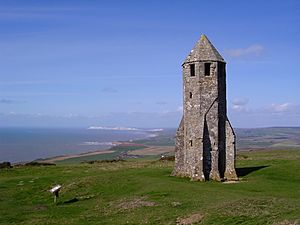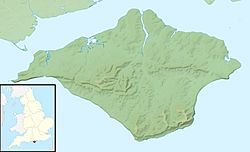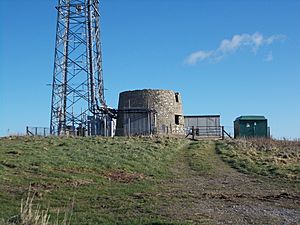St. Catherine's Oratory facts for kids
 |
|
| The "Pepperpot" on St. Catherine's Hill. | |
|
|
|
| Location | St. Catherine's Down Isle of Wight |
|---|---|
| Coordinates | 50°35′35″N 1°18′14″W / 50.593167°N 1.303889°W |
| Year first lit | 1328 |
| Deactivated | 1547 |
| Construction | stone tower |
| Tower shape | octagonal tower with pyramidal roof |
| Height | 10.8 metres (35 ft) |
St. Catherine's Oratory is a very old lighthouse from the Middle Ages (a long time ago!). It stands on St. Catherine's Down, high above the southern coast of the Isle of Wight. People often call it the "Pepperpot" because it looks like a pepper shaker!
This special tower was built by a lord named Walter de Godeton. He lived in a place called Chale. He built the lighthouse to make up for taking wine from a shipwreck in Chale Bay in 1313.
St. Catherine's Oratory: Britain's Oldest Lighthouse
The "Pepperpot" is Britain's only lighthouse still standing from the Middle Ages. It is also the second oldest lighthouse in the country. Only a Roman lighthouse in Dover is older!
It is made of stone and has four floors. The outside is shaped like an octagon (an eight-sided shape). The inside has four sides. It was originally connected to another building, and you can still see parts of those old walls.
Why Was the Lighthouse Built?
Walter de Godeton got into trouble for taking the wine from the shipwreck. First, he was tried in Southampton and had to pay a large fine.
But the wine was meant for a church in Picardy, France. So, the Church also got involved. They told Walter de Godeton he would be forbidden from church services unless he built a lighthouse near Chale Bay. This was his way of saying sorry and helping others.
There was already a small church building, called an oratory, on top of the hill. It was named after St. Catherine. The lighthouse was added to this site. It also had a small room, called a chantry, for a priest. This priest would look after the light and hold church services for sailors in danger at sea.
Its History Through the Years
Walter de Godeton passed away in 1327, but the lighthouse was finished in 1328. It was used actively until the Dissolution of the Monasteries. This was a time between 1538 and 1541 when many monasteries and religious buildings in England were closed down.
Much later, in the 1700s, a man named Sir Richard Worsley from Appuldurcombe House helped make the tower stronger. He added four big supports to stop it from falling down.
Nearby, you can find the foundations of another lighthouse that was started in 1785. However, it was never finished. This is because the hill often gets very thick fog, which would make a lighthouse there not very useful. These old foundations are known locally as the "salt cellar."
The lighthouse that is used today, St. Catherine's Lighthouse, was built much closer to the sea. It stands on St. Catherine's Point. It was built after a ship called the Clarendon crashed in 1837.



